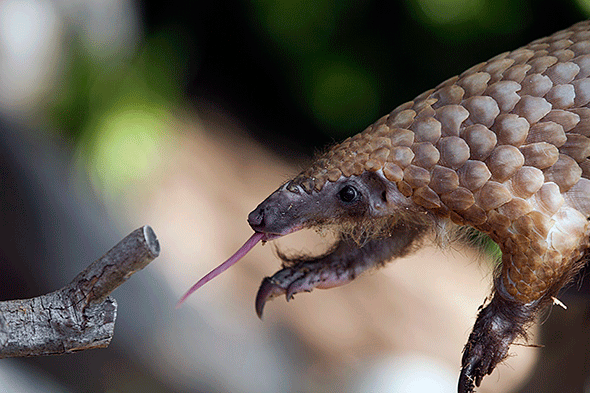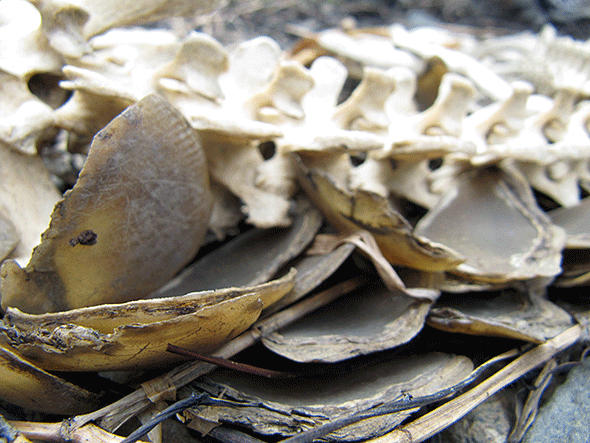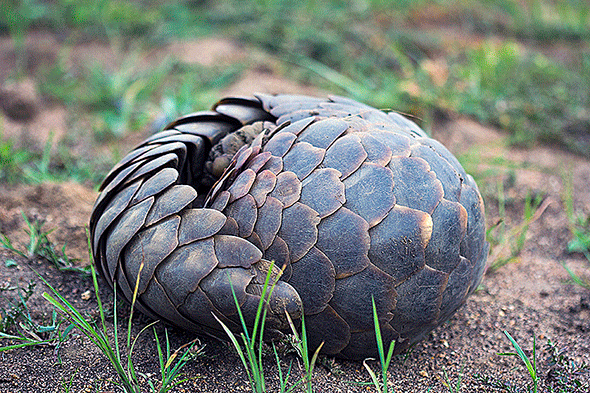
|
Published: 25 November 2014
Local people may be the key to scaling back wildlife crime
Law enforcement has been largely ineffective in slowing the global wildlife trade. What’s really needed, say experts from the International Union for the Conservation of Nature (IUCN), is more participation by local communities in wildlife conservation efforts. The plight of the pangolin – the world’s only mammal with scales – is a case in point.

|
|
Pangolins have an extremely long tongue to find and eat their preferred diet of termites and ants. Credit:
©istock.com/DarrenBradleyPhotography
|
The pangolin or scaly anteater is the most widely traded illegal animal in the world, with over one million believed to have been traded illegally in the last decade. They are in demand not just for their meat, but also for their scales, which are made from keratin and ascribed special healing properties in both Chinese and African traditional medicine.
According to the IUCN’s Red List of Threatened Species, all eight of the world’s pangolin species – found in parts of tropical Africa and Asia – are threatened with extinction. As pangolin species become rarer their value rises, increasing the incentives to hunt and trade both live and dead animals. In some areas of China, they are already extinct.
Illegal trafficking of pangolins across borders is extensive and hard to monitor. The wreckage of a recent car crash in Thailand revealed 133 live pangolins, six carcasses and 100 sacks of pangolin scales. Worldwatch Institute data from reported wildlife seizures shows that at least 49 662 pangolins have been smuggled from Indonesia since 2002. In Thailand, border officials seized 7734 pangolins between 2003 and 2008.
‘We don’t know a lot about actual numbers of pangolins, so quantifying the impact of trade on pangolin populations is problematic, but we know from history, the pangolins have long been exploited from international trade,’ says Dr Dan Challender, Co-Chair of the IUCN Pangolin Specialist Group.
He adds that by the end of the 1990s, pangolins had all but disappeared from China, forcing the Chinese market to source pangolin products from elsewhere. ‘Most of the trade, as we understand it, goes to China from the neighbouring countries of Laos, Vietnam, Myanmar, and now from further afield – from Indonesia, Malaysia, India, Pakistan and Africa.’
Despite its popularity as an Asian ‘bush meat’ delicacy, little is known about this shy and secretive animal. We do know they’ve developed an extremely long tongue to find and eat their preferred diet of termites and ants. And pangolins usually give birth to one soft-scaled baby at a time. The baby rides on the mother’s tail or back, staying with her until sexual maturity at around two years of age, when she abandons it.
But this and the other frugal bits of information we have on the ecology, habitat and distribution of pangolins comes from local poachers, hunters and park rangers.
Dr Rosie Cooney, Chair of the IUCN’s Sustainable Use and Livelihoods Specialist Group (SULi), ran a workshop on ways of controlling the illegal animal trade at the recent IUCN World Parks Congress in Sydney.
Dr Cooney points out that those charged with conserving threatened species basically have three strategies available to them: enforcement, reducing demand by consumers in end-markets (for pangolins, they are in East Asia), and working with the communities who live alongside the animals.
‘We would like to see a strong emphasis on enforcement but not strong top down enforcement at the expense of local people,’ she says. She is investigating why local people are complacent in wildlife crime in some contexts, while other situations local people are involved in enforcement.

|
|
Pangolin scales and skeleton: the scales are thought to have medicinal properties. Credit:
Flickr/Daphne Chui CC BY-NC-SA 2.0
|
Dr Cooney says the focus of IUCN’s SULi is on supporting local livelihoods and providing them with incentives to not engage in illegal trade – for example, through sharing in profits from sustainably operated hunting safaris, or from wildlife farming. She says ‘this conversation is really not being had’, as governments focus on the enforcement and demand reduction that have easy and quantifiable targets.
Dr Cooney also says that wildlife conservation agencies also need more information about the poachers. ‘One of the factors that has comes out of the CITES (Convention on International Trade in Endangered Species of Wild Fauna and Flora) Monitoring the Illegal Killing of Elephants (MIKE) program is the correlation between illegal wildlife poaching and poverty.’
The IUCN recently launched a website dedicated to pangolin conservation and published its pangolin Specialist Group Conservation Action Plan.
Speaking to the Action Plan, Dr Challender says, ‘Our global strategy to halt the decline of the world’s pangolins needs to be urgently implemented.
‘A vital first step is for the Chinese and Vietnamese governments to conduct an inventory of their pangolin scale stocks and make this publicly available to prove that wild-caught pangolins are no longer supplying the commercial trade.’
The Action Plan also outlines research areas that will inform conservation efforts. One of these is to understand how pangolin populations behave and how much habitat they need to maintain an ongoing population.
‘At the same time we need research into demand reduction and the social norms around the consumption of pangolin products,’ adds Dan. ‘We need to do this so we can inform interventions, be it social marketing or behaviour change programs to shift consumers away from pangolins to preferably away from something that’s not endangered.’
For pangolins and other animals used for traditional medicines, there is some hopeful news. Wildlife trade monitoring network TRAFFIC has reported that several leading traditional Chinese medicine companies recently renounced the use of endangered plants and animals in medicinal products. Whether this commitment is followed through remains to be seen.
|
There are eight living species of pangolin, all of which reside in one taxonomic family, the Manidae, and one order, Pholidota. |
Of the eight species of pangolin, four are found in Asia, the Chinese pangolin (Manis pentadactyla), Indian pangolin (M. crassicaudata), Sunda pangolin (M. javanica), and the Philippine pangolin (M. culionensis). Together their range extends from Pakistan eastward through southern China, south from the Himalayas in Nepal and throughout the Indian sub-continent including Sri Lanka, as well much of mainland and island Southeast Asia, including the Palawan faunal region in the Philippines. |
Four species also occur in sub-Saharan Africa: the Temminck’s ground pangolin (Smutsia temminckii), giant ground pangolin (S. gigantea), white-bellied pangolin (Phataginus tricuspis) and black-bellied pangolin (Uromanis tetradactyla). |
Pangolins occupy a diverse range of habitats from tropical and sub-tropical forests, dry woodland and savannah regions, as well artificial and modified habitats such as oil palm and rubber plantations. They are predominantly nocturnal though have been known to be active during the day, and are characteristically elusive – one of the reasons why they remain understudied. |
(Sourced from the July 2014 IUCN report Scaling Up Pangolin Conservation) |


